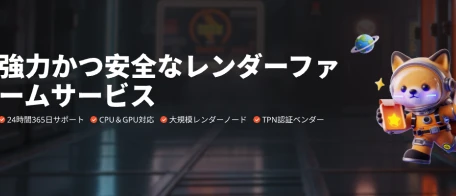詳しくはこちら
2025年11月10日(土)〜12月31日(水)(UTC+8)
Fox Renderfarmに関して
必要な時に必要なレンダリングパワーを!
レンダリング時間を大幅短縮
安心で使える
プロチームを支援する
多様なソフトウェア及びプラグインに対応
初期設定は不要、すぐに使える
より合理的な価格体系
業界をリードするクラウドレンダーファーム
- 数千台のレンダーノードを有する
- 何千台ものノードを即座に起動可能(使用ノード数はユーザーが指定できます)
- マルチOSサポート
- 当社のクラウドレンダリングサービスはWindows、Mac、Linuxに対応し、99.99%の高稼働率を誇ります
- 自動検出機能
- IT環境を自動的に検出して、クラウド・インフラストラクチャ・サービスで調整
- API対応
- APIの公開によるユーザーアプリケーションからのファームのダイレクト制御が可能
- 即時レンダー
- 高機能で遅延のないサービス
- CPUおよびGPUレンダリング
- CPUレンダリングとGPUレンダリングを任意に選択可能
- 大規模SSDストレージ
- 入出力のボトルネックを解消する高性能SSDストレージソリューション
- 高速データ転送
- Raysyncの高速データ転送により、リアルタイムでのファイルのアップロードとダウンロードが可能になります��。
安心してお使いいただける理由
認定規格:ISO/IEC27001:2022(ISMS)
認定番号:19022ISM000230R1
Fox Renderfarmサポートチーム
Fox Renderfarmのプロのカスタマーサービス&技術サポートチームがお待ちしております!
- オスカー受賞制作チームのパートナー
- 24時間365日の顧客対応&技術サポート
- WhatsApp/Email/ライブチャット/Telegramでの連絡が可能
- ハリウッドで制作経験のあるスタッフが業務をお手伝いします。
- 返答時間:15分以内(ケースによってはお時間を頂くこともあります)
Fox Renderfarmは主な3Dソフトウェア、レンダラー、プラグインをサポートしています
- 3ds Max
- Maya
- Blender
- Unreal Engine
- Arnold
- V-Ray
- Corona
- Nuke
- Katana
- Octane
- RenderMan
- anima®
- Forest Pack
- RailClone
- X-Particles
- Miarmy
さらなるソフトウェアの情報を知るためにお問い�合わせください
最大<span class='discount'>100%</span>のボーナス
一年で一番お得なセール!
プロジェクトのアップロード、レンダリング、ダウンロードがシンプルです
たった四つのステップでプロジェクトをレンダリング
お客様からの声
100か国及び地域の40万以上のユーザー。
- デイビッド・グオ 様
- ご愛顧いただいているお客様からの声
- ハジ・ブルハヌディン 様
- ヤン・ミカ 様
より合理的な価格体系
レンダリングを開始前の料金試算
- 無料でトライアル
- 低価格
- 【50%OFF】セール
- 産業支援
Cloud Render Farmの業界支援
- 教育割引
- スポンサーシップ
- フリーランサー支援
ニュースセンター
- Journey Back to Pandora: Avatar: Fire and Ash in Theaters Soon!
- Pixar and Disney Leap Into a Hidden World with "Hoppers"
- Skeletal Animation Explained: A Complete Guide for 3D Characters



